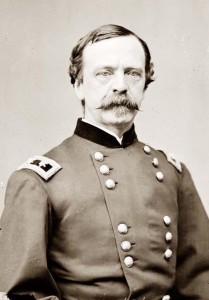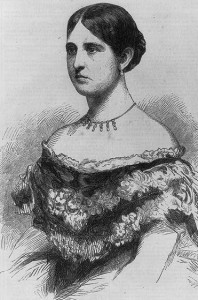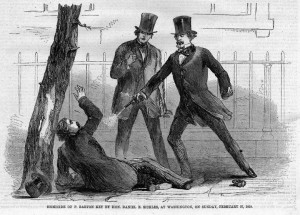Daniel E. Sickles
Saturday marks the (probable) 193rd birthday of one of the most interesting characters in the story of the Battle of Gettysburg: Major General Daniel Edgar Sickles.

At Gettysburg, General Sickles commanded the Union 3rd Corps – a force of nearly 10,000 men – assigned to defend the left flank of the Army of the Potomac (AoP) on July 2, 1863. Sickles played a major & decisive role in the battle that day, but it is his story leading up to that point which provides the most drama.
Although most people don’t know of him today, in 1863, “Sickles” was a household name. Unlike most Generals in the AoP, he did not attend the United States Military Academy at West Point. He had no experience as a soldier. His experience was in politics, as a Democrat from New York. By age 22, he was a member of the New York State Assembly, and became involved in the Tammany Hall political machine. During his time in the state legislature, he was charged or indicted multiple times for misappropriating funds for projects he worked on. He was also accused of theft, brawling, and tampering with elections. There was even a time that he was censured by his colleagues for bringing a known prostitute into the chamber of the legislature as his guest (possibly as part of a vote-buying scheme of some kind).
At the age of 33, he married Teresa Bagioli, the 16-year old daughter of one of his friends (he had met his future wife when she was 2 years old). As you might guess, her family did not approve of the marriage, so the two were married in a small civil ceremony. She gave birth to a daughter named Laura not long after (although Laura’s actual birthdate is less than clear). Married life did not do much to affect Sickles’ womanizing ways however, and he continued to “cavort with low women” for most of his life.

In 1856, his Tammany connections got him elected to Congress, and Sickles moved his family to a very nice house in Washington, DC on Lafayette Park (just across the square from the White House). There are some questions as to how he was able to afford such a place, as the rent was more than he was making as a Congressman.
While Sickles was busy with his political career (and all those women), Teresa – as the wife of a Congressman – was expected to either attend or host a party nearly every night of the week. That’s just how things were in 19th century Washington. Since Congressman Sickles was so busy, it was considered to be perfectly acceptable – even encouraged – for Teresa to be escorted to these parties by another man. On a few occasions, she was escorted by a man named Philip Barton Key. Not only was Key an extremely handsome widower and a U.S. Attorney for DC, he was also the son of Francis Scott Key – a name familiar to Baltimoreans as the author of the Star Spangled Banner. Almost certainly aware of her husband’s own affairs, Teresa was enamored by Key and the two started a (not so) secret romance.
Key rented a house that he exclusively used as a hookup spot not far from Sickles’ place, and would walk to Lafayette Park waving a handkerchief in the air as the signal for Teresa to come and meet him for a rendezvous. Sickles was either too busy, or too stupid to notice that this was going on.
One day, Sickles received an anonymous letter (we still don’t know who sent it) laying out the details of what his wife was up to:
Dear sir with deep regret I enclose to your address the few lines but an indispensable duty compels me so to do seeing that you are greatly imposed upon. There is a fellow I may say for he is not a gentleman by any means by the [name] of Philip Barton Key & I believe the district attorney who rents a house of a negro man by the name of Jno. A Gray situated on 15th Street btw’n K & L streets for no purpose than to meet your wife Mrs. Sickles. He hangs a string out of the window as a signal to her that he is in and leaves the door unfastened and she walks in and sir I do assure you he has as much the use of your wife as you have. With these few hints I leave the rest for you to imagine.
Most Respfly
Your friend R. P. G.
Sickles didn’t believe it at first. It took a few more of his friends mentioning his wife’s odd behavior before he angrily confronted her. She confessed, and at Sickles’ request, wrote out a letter describing exactly what she had been up to. It was scandalous. Sickles sent Teresa back to New York, and became extremely upset. Key didn’t know that any of this was happening, and he continued with his occasional signaling from the park as before.
On February 27, 1859, Sickles happened to be looking out the window as Key waved his handkerchief. He absolutely lost it. Grabbing two pistols, he stormed out front to take his revenge. As he got closer to Key, Key started to panic and pleaded for his life as Sickles shot him at least twice and then calmly walked to the house of the Attorney General to turn himself in. Key died a few minutes later.

The trial was a media circus. It was the 19th-century equivalent of the O.J. Simpson trial – a celebrity sex scandal, turned murder. Unlike the Simpson trial though, Sickles had public opinion on his side. People in those days felt that if your wife was cheating on you, you should be able to take care of that situation yourself. His defense team was extremely innovative, devising an argument that had never been used before in American history: temporary insanity. The story was that Sickles went insane when he saw Key, killed him, and then clearly stopped being insane when he calmly turned himself in.
The jury bought it. Sickles was acquitted of murder charges.
Where Sickles went wrong was shortly after the trial. He came out and publicly forgave his wife for the affair. Public opinion instantly flipped on him. People thought, “if you could forgive her now, why couldn’t you forgive her before killing Key?” Sickles now had a PR problem.
So how does a shady politician who has quite literally admitted (in Federal court, no less!) that he was insane, end up in command of 10,000 troops at the pivotal battle of the Civil War? The answer (as you might imagine) lies in politics.
But that’s a story for another post….
Happy Birthday, Dan!
Also – If you’re interested in learning more about Dan Sickles, may I suggest James Hessler’s outstanding book, Sickles at Gettysburg? While it focuses specifically on his involvement with Gettysburg (both during and after the war) it gives a good overview of his life in the process.
